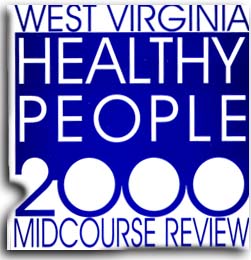 |
Family Planning |
 |
Family Planning |
Background
Family planning involves establishing the preferred number and spacing in a family and selecting the means by which this objective is accomplished. Effective family planning and avoidance of unintended pregnancy may assist in reducing the incidence of maternal morbidity, low birthweight, and infant mortality because of more adequate spacing between pregnancies and good gynecological health care. The West Virginia Family Planning Program provides comprehensive reproductive health care for low income women, men, and adolescents by providing services and education to prevent unintended pregnancies.
When federal funding was made available for family planning in 1970, the Office of Maternal and Child Health (OMCH), West Virginia Bureau for Public Health, accepted responsibility for the program. Services were initially developed through the county health departments across the state. Later, as primary care centers were created, they were added to the service delivery area. Currently, the Family Planning Program contracts with 128 provider sites across the state (see map on next page). The Family Planning Program is the lead agency in meeting the objectives.
STATUS OF FAMILY PLANNING OBJECTIVES |
|||
OBJECTIVE |
Baseline (1990) |
Midcourse (1995) |
Target (2000) |
| 5.1 Reduce unintended pregnancies to 30% | 37.8% (1989) |
56.0% (1994) |
30.0% |
| 5.2 Increase to at least 85% ages 10-18 who have discussed human sexuality with their parents | Data not available |
||
| 5.3 Increase to at least 90% ages 19 and younger who use contraception | Data not available |
||
| 5.4 Contain pregnancies ages 15-17 to 50 per 1,000 | 50 |
NA |
50 |
The Objectives
OBJECTIVE 5.1 Reduce to no more than 30% the proportion of all pregnancies that are unintended.
UPDATE Data provided by the Pregnancy Risk Assessment Monitoring System (PRAMS) for 1994 indicated that 56% of the women surveyed wanted to be pregnant either sooner, later, or not at all. This compares to baseline data from the 1988/89 PRAMS surveys that indicated that 37.8% of women surveyed wanted to be pregnant sooner, later, or not at all. A 1990 report by the Alan Guttmacher Institute estimated that 93,460 West Virginia women at or below 185% of the federal poverty level were at risk of unintended pregnancy.
OBJECTIVE 5.2 Increase to at least 85% the proportion of people aged 10-18 who have discussed human sexuality, including values surrounding sexuality, with their parents and/or have received information through another parentally endorsed source such as youth, school, or religious programs.
UPDATE West Virginia baseline data addressing this objective are not available. Data are to be tracked nationally using the National Health Interview Survey. Early sexual activity is strongly associated with unintended pregnancies, sexually transmitted diseases, and negative effects on social, physiological, and psychological development. Data from the 1995 Youth Risk Behavior Survey indicated 61% of West Virginia high school students reported having engaged in sexual intercourse. Also, 11% of respondents reported having sexual intercourse for the first time prior to age 13.
OBJECTIVE 5.3 Increase to at least 90% the proportion of sexually active, unmarried people aged 19 and younger who use contraception, especially combined method contraception that both effectively prevents pregnancy and provides barrier protection against disease.
UPDATE No state-specific baseline data currently exist for this objective. In both the United States and West Virginia, the number and percentage of live births occurring out-of-wedlock have risen steadily during the past decade. Approximately three out of every ten (30.5%) resident births in 1995 were to unmarried mothers. The percentage of out-of-wedlock births among teenage mothers was 64.5%.
(ADDED 1996) OBJECTIVE 5.4 Contain pregnancies among females aged 15-17 to no more than 50 per 1,000 adolescents.
UPDATE According to 1990 Alan Guttmacher Institute data, the pregnancy rate for state females aged 15-17 was 50 per 1,000 adolescents. The Institute estimated that in that year there were 35,540 teenagers at risk for unintended pregnancy in West Virginia. The Family Planning Program is concerned with serving sexually active adolescent clients in a manner that is sensitive and supportive. During 1995, 23,713 female teens and 1,171 male teens were served in family planning provider sites. Adolescents currently constitute 32.8% of the total client load.
Meeting the Objectives
Health
Promotion Channels Worksites |
The West Virginia Family Planning Program is addressing Objectives 5.1-5.4 through the health promotion channels to the communities listed in the box. The Director of the Program is the contact person for plan development and strategies aimed at accomplishing the family planning goals for West Virginia. There has been a steady increase in the number of clients receiving clinical services each year. Over the past five years, the Program has seen a 6% growth in clients utilizing contraceptive services. The data reflect a growing need for subsidized services. Strategies to meet the objectives include the following:
Family planning is a preventive measure that supports reproductive health, as well as the emotional and social health of individuals and families. Family Planning Program services have had, and will continue to have, a significant impact on maternal and child health and the socioeconomic status of West Virginians.
Family Planning - Meeting the Objectives
Lead Entity: |
Plan Coordinator: |